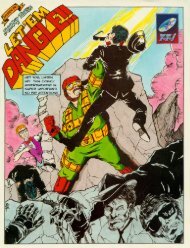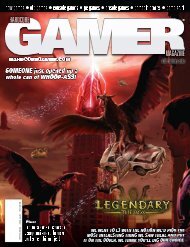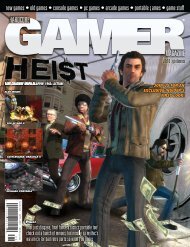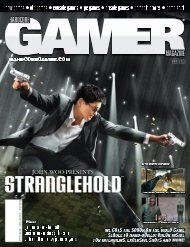Create successful ePaper yourself
Turn your PDF publications into a flip-book with our unique Google optimized e-Paper software.
SUBJECT: FRAME CANCELING<br />
BY<br />
Architect: Lynxara<br />
Platform: PlayStation Portable BLUEPRINTS FOR:<br />
Generation of Chaos is unusual among strategy RPGs for its real-time battle system. This and the game’s 2D graphics combine to<br />
introduce a very important element into battles: hitstun and frame canceling. Exploiting this properly lets you win battles even if<br />
your unit is pretty underpowered. When you’re fighting bosses like the Dragon Kings, it can end up being the only way to win.<br />
It just takes too long to aim those<br />
little bows.<br />
Before we can get into frame canceling, though, let’s<br />
go through some basics. Hitstun is a concept that should<br />
Once you’re in hitstun, you’re gonna<br />
be stuck there for awhile.<br />
be quite familiar to anyone who’s ever played a 2D action<br />
game, particularly a 2D fighting game. As a character takes<br />
damage, he or she becomes temporarily immobile and<br />
becomes trapped for a few fractions of a second in a “getting<br />
hit” animation. In GoC, each character on the field is<br />
subject to hitstun when damaged by an enemy attack.<br />
The attack cycle is the period of time<br />
required for a character to complete an attack,<br />
including their wait period and the time<br />
it takes to complete their attack animation.<br />
The length of the attack cycle varies according<br />
to a character’s SPD stat and their unit<br />
type. A high-SPD archer like a Marine<br />
may still have a longer attack cycle<br />
than a low-SPD Knight, simply because archers have more frames of animation to get through before they can<br />
start dealing damage. Hitstun is a significant factor in GoC’s combats because entering hitstun forces a character<br />
to restart their attack cycle from the beginning.<br />
Frame canceling is a trick for avoiding damage you can pull off by carefully exploiting the way the attack cycle works. Any given<br />
attack cycle culminates in damage frames, the precise moments in the attack animation where the opponent takes damage. A curious<br />
element of GoC’s battle engine is that damage is not subtracted from<br />
your opponent’s HP total until after your damage frame has connected, the<br />
opponent has entered hitstun,<br />
and the damage total numbers<br />
The battle stops as you make your have appeared above his or her<br />
decision.<br />
head. If any given frame of this<br />
process is interrupted before the<br />
damage numbers appear, then the<br />
attacker must restart his or her attack cycle as if they had entered hitstun and<br />
no damage is dealt to the opponent.<br />
It’s entirely possible for one of your troops to hit an opponent at just the<br />
right time, and frame cancel by abruptly forcing him or her into hitstun. Taking<br />
damage in GoC always takes priority over dealing damage. The problem<br />
with relying on your troops to produce frame cancels is, of course, that your troops aren’t directly under your control. Whether or not<br />
their attacks happen to have the right timing for a frame cancel is entirely a matter of chance.<br />
The best ways to achieve a frame cancel is by using interrupting events — Items, Skills, and Supers. The menu you access these<br />
commands from is causes all action onscreen to freeze — effectively, giving the menu priority over all other combat actions. If you simply<br />
exit the menu the attack cycle will proceed normally, but if you use the Item, Skills, or Super commands, then that event interrupts<br />
everything else happening on the battlefield. These events are themselves<br />
completely uninterruptible and cannot be cancelled.<br />
Which of your options<br />
you pick and what it does<br />
makes no real difference in<br />
terms of frame canceling your<br />
opponent’s attack. A weatherchange<br />
Super or a healing<br />
See all those attacks not connecting?<br />
That’s lost damage.<br />
Item cancels just as well as a massive-damage Skill or Super. It’s smartest to<br />
use the most abundant resources you can for canceling. Super meter builds<br />
automatically throughout the battle, so it’s best to cancel with Supers when<br />
you have the option. If you can’t use a Super, then resort to whatever Skills<br />
your commander has available. Canceling with an Item should be a last-ditch<br />
desperation move, unless it’s something like Soul Contract where you benefit more from using it earlier in the combat.<br />
Bear in mind that interrupting events like Supers, Skills, and Items can frame cancel your own actions as well as those of the<br />
enemy. If your commander is finishing his attack cycle but hasn’t yet gotten to his damage frames, then triggering an interrupting event<br />
duly cancels his attack. It’s easy to avoid doing this to your commander, but it’s a bit harder to make sure you aren’t needlessly canceling<br />
your own troops’ attacks when you go to frame cancel. Before trying to use frame canceling heavily in battle, make sure you have a<br />
very good grasp of roughly how long your troops’ attack cycles are and what their damage frames look like. It’s simply a waste to use an<br />
interrupting event to frame cancel if your troops were about to cancel the attack anyway.<br />
There’s a big exception to this caution if you’re using a long-range unit, like a Magician, Marine, or Gunner. GoC’s combat engine<br />
interprets the attack cycle of long-range characters in an interesting way, with the projectile launched by the character functioning as<br />
their damage frames. The projectiles, however, exist persistently, while the<br />
damage frame of a melee-range character exists only for as long as it takes<br />
them to cycle through that part of<br />
Think of that little ball of a light<br />
as a traveling damage frame.<br />
their attack animation.<br />
If you’re using a longrange<br />
unit, it’s entirely possible<br />
to have your unit launch their<br />
attack projectiles, quickly use an<br />
interrupting event to frame cancel whatever the enemy is doing, and then<br />
watch as all the attack projectiles hit the helpless enemy after the event<br />
finishes. When fighting a long-range unit, you need to remember that you<br />
have to frame cancel the enemy’s attack before they reach the part of their<br />
attack cycle where their projectile appears. it’s too late to try and cancel<br />
once the enemy’s projectile has begun its approach. It is possible to cancel damage from projectiles by letting them hit you and then<br />
quickly triggering an event before the damage total appears, but the window of time for doing this is so short that it’s difficult to pull<br />
off consistently.<br />
70_STRATEGY_DOUBLEJUMPBOOKS.COM_GENERATIONS OF CHAOS HARDCORE GAMER MAGAZINE_VOLUME 1_ISSUE 9_WARM BUN HARDCORE GAMER MAGAZINE_VOLUME 1_ISSUE 9_WARM BUN<br />
GENERATIONS OF CHAOS_DOUBLEJUMPBOOKS.COM_STRATEGY_71














